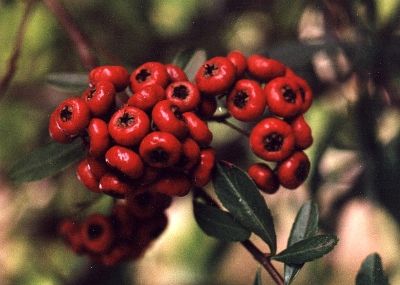Pyracantha
by Valerie (May 27, 2001)

Having never heard of the common name firethorn until recently, we have always referred to this shrub as pyracantha, which happens to be its genus name. There are several species and I'm still unsure which we have. The bush grew unexpectedly and for several years I just pruned the bottom branches until it is now in the form of a small tree 6 feet tall with a 1½ inch trunk. The past couple of years it has produced pretty little bouquets of five-petal white flowers, followed by clumps of berries that stay green all summer, turning red in the fall. These eventually disappear by spring, probably eaten by birds. The plant retains both its leaves and berries through the winter.  Although the plant has thorns, they are not nearly as bothersome as those on agaves, cactus, roses, coralbean trees, retama, or various briers. In fact, I had barely even noticed the few thorns while pruning the plant. Obviously, some people are much more aware of the spines (perhaps with other species), hence the name "firethorn." I have heard that pricks from this plant produce an allergic reaction for some that is comparable to bee stings, causing painful swelling. Because of its spines, it is often used as a thorny barrier hedge. The leaves of our plant are small, glossy and dark green. There are quite a number of commercially available cultivars of this shrub, produced mainly for the attractive berries. It does very well in our climate and requires no extra watering.
Although the plant has thorns, they are not nearly as bothersome as those on agaves, cactus, roses, coralbean trees, retama, or various briers. In fact, I had barely even noticed the few thorns while pruning the plant. Obviously, some people are much more aware of the spines (perhaps with other species), hence the name "firethorn." I have heard that pricks from this plant produce an allergic reaction for some that is comparable to bee stings, causing painful swelling. Because of its spines, it is often used as a thorny barrier hedge. The leaves of our plant are small, glossy and dark green. There are quite a number of commercially available cultivars of this shrub, produced mainly for the attractive berries. It does very well in our climate and requires no extra watering.
The berries are edible and there are recipes for jelly. It is said to resemble apple jelly and uses a huge amount of sugar. Since our plant has only been producing berries for a couple of years, it is interesting that the rate of berry production this year is exponentially greater than last year. The plant is covered with them. It should make for a lovely fall color display in a few months. |